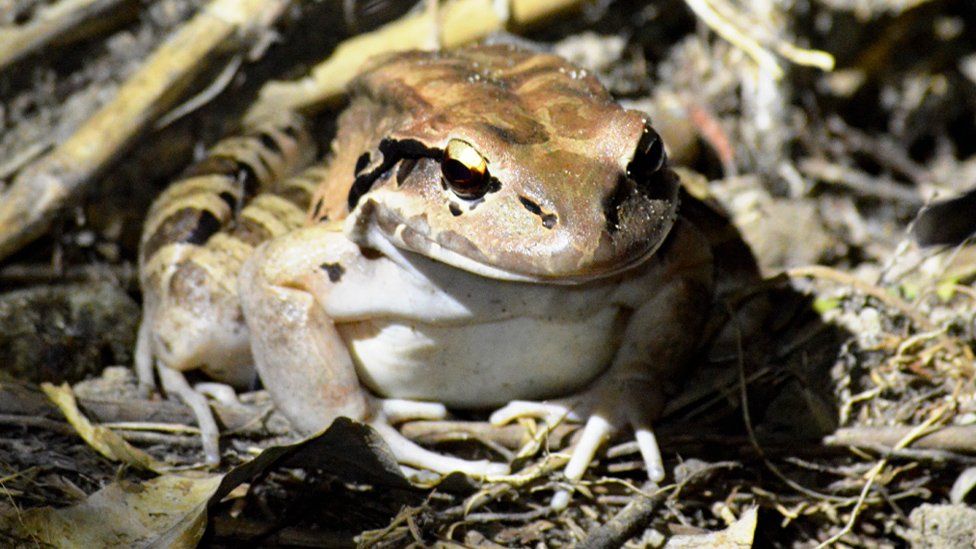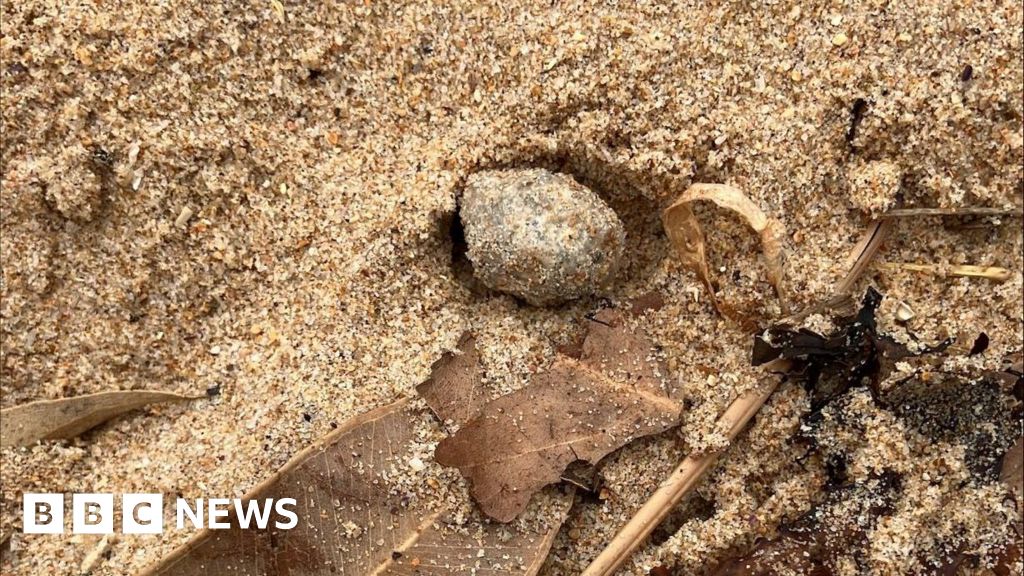ARTICLE AD BOX
 Image source, Anselm Gibbs
Image source, Anselm Gibbs
The mountain chicken frog, also called giant ditch frog, can weigh up to 1kg
By Anselm Gibbs
Roseau, Dominica
A frog that has been cooked and eaten for decades on the Caribbean island of Dominica is on the verge of becoming extinct, but there is now a frantic push to try to save it.
The mountain chicken frog (Leptodactylus fallax) was once considered Dominica's unofficial national dish, according to locals.
"When I used to cook it, I would just cut it and put it into a broth," says Alain Mellow as he sits selling fruit and vegetables in Roseau, the bustling capital city of Dominica.
It tasted "just like chicken", according to Mr Mellow, who is now in his 70s, and believes the nutrients from the mountain chicken frog have contributed to his good health.
Image source, Anselm Gibbs
Image caption,Alain Mellow remembers eating mountain chicken frogs
Another local name for the mountain chicken is "crapaud" (the French word for toad), a reminder of Dominica's past as a French colony.
There were different ways to cook the four-legged creature. Some preferred to include it in a stew, while others salivated over the golden-brown fried option.
In this country nicknamed "the nature island" because of a vast presence of varied flora and fauna, the frog's importance is highlighted by its presence on the national coat of arms.
However, anyone visiting a restaurant on the Eastern Caribbean island now, or over the last two decades, may not have even heard of the mountain chicken frog as a delicacy.
Kenasher Valmond, who works at a café near the sea port in Roseau, says she has never eaten mountain chicken.
"I've never seen it," says Ms Valmond, who is in her 20s. "I just heard people speaking about it."
According to experts, the main reason for the frog's disappearance from dining room tables and its decline in popularity among younger people is an infectious amphibian disease called chytridiomycosis.
"In a span of a year-and-a-half we lost almost 90% of the mountain chicken population in Dominica," Jeanelle Brisbane, a wildlife ecologist in Dominica, tells BBC News.
Image source, Anselm Gibbs
Image caption,Jeanelle Brisbane says the population was decimated by chytridiomycosis
"It was one of the fastest amphibian declines on record in our history." That has led to the frog now being listed as critically endangered.
On a warm April night, BBC News journeyed into the forest with Ms Brisbane and her team from Dominica's forestry division and the non-governmental organisation Wild Dominique.
We set out to find one of the few surviving frogs in the wild, but were advised not to disclose the exact location to prevent poachers from targeting it.
As we made our way through the pitch dark area, Ms Brisbane alerted us to the distinct calling sound of a mountain chicken, prompting us to halt our trek and wait in silence, but we were unable to determine where the frog was located.
As we continued along a river bank - after a couple of false alarms, seeing other frog species - there, on the other side of the river, sat a mountain chicken frog, illuminated only by the light from our headlamps.
Image source, Anselm Gibbs
Image caption,The team finally spotted a Leptodactylus fallax
The frog is one of the largest in the world, and can grow up to 1kg (2.2lb) in weight according to the Zoological Society of London (ZSL), but it was no match for the deadly microscopic fungus.
The chytrid fungus began wreaking havoc in Dominica around 2002, according to researchers.
The frog is also battling for survival on another Caribbean island to the north.
"The disease got to Montserrat as well and completely wiped the species off the map," says Andrew Cunningham, the deputy director of science at the ZSL.
Mr Cunningham says that fortunately some of the frogs were put into captive breeding programmes in Montserrat before they disappeared completely.
He describes the disease as a massive problem, saying it has caused the probable extinction of over 90 species of amphibians globally.
In Dominica, before the fungus struck, harvesting the frog from the wild was a booming business, with studies finding up to 36,000 frogs being hunted each year, according to Ms Brisbane.
After coming under attack by the chytrid fungus, the frog's population took a further hit by the passage of Tropical Storm Erika in 2015 and Hurricane Maria two years later.
"Our forests have essentially grown silent because of the absence of the mountain chicken voice, it was a huge part of our soundscape, of what put us to bed at night," Ms Brisbane says.
Several partners, including ZSL and Dominica's forestry division, have come together as part of the Mountain Chicken Recovery Programme.
During a population count conducted last year in parts of the island the frog was known to inhabit, only 21 frogs were found alive in the wild.
Researchers at ZSL say that while the total number of mountain chicken frogs in Dominica's forest is probably higher than the 21 they located, it is unlikely to add up to more than 30.
"They were one of the apex predators on the island, so losing those has potential ripple effects in terms of pest control," says Benjamin Tapley, a Curator of Herpetology at ZSL.
In March, ZSL announced the appearance of six mountain chicken froglets at London Zoo, after two of the frogs that were brought from Montserrat successfully bred for the first time in five years.
Image source, ZSL
Image caption,Two mountain chicken frogs from Montserrat successfully bred at London Zoo
Another positive sign is that the surviving frogs in the wild in Dominica seem to have developed some type of resistance to the chytrid fungus, according to Mr Cunningham.
However, that resistance has not been found in mountain chicken frogs in Montserrat, where the only living frogs of this type are believed to be those in controlled environments and not in the wild, according to researchers.
Research continues as there is a network of zoos in different parts of the world, with roughly 200 mountain chicken frogs in captivity.
"We need to now figure out how we can get the genetics from these frogs and integrate them into the whole population, so that we can have the hope of reintroducing all these frogs into the wild," Ms Brisbane says.
Dominica's culture and heritage are deeply rooted in its natural environment, according to Ms Brisbane, so "it's not just saving a frog, it's saving ourselves".

 8 months ago
54
8 months ago
54








 English (US) ·
English (US) ·